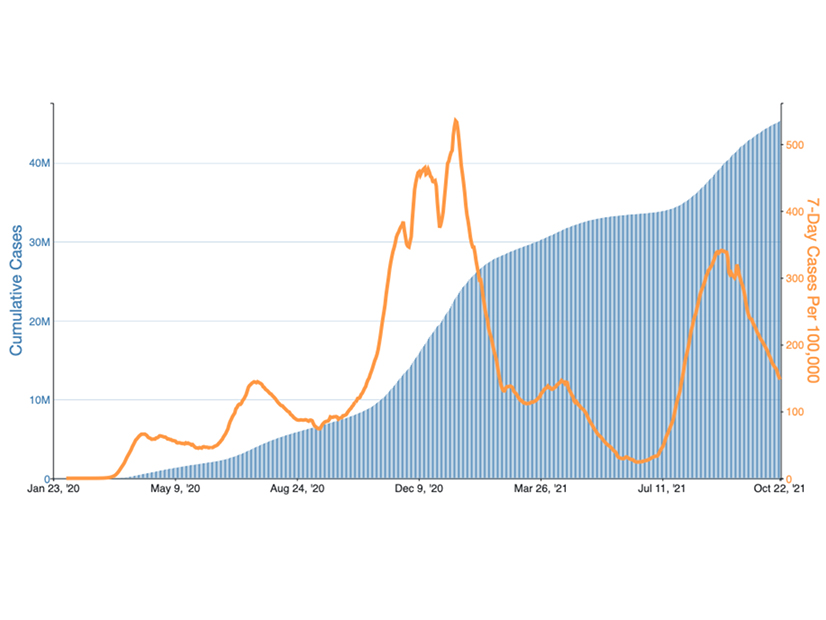
In a Lessons Learned report published Monday, NERC reviewed the electric industry’s response to the COVID-19 pandemic and provided possible paths for the future based on the experience.
More than 45 million cases of the novel coronavirus have been reported to the Centers for Disease Control and Prevention (CDC) since January 2020, and more than 730,000 deaths. NERC first indicated it was working on a report about the industry’s pandemic response more than a year ago, but the idea dates back to the earliest stages of the outbreak, when utilities began to adjust their business practices to reduce the risk of losing critical personnel while still providing full service to customers. (See NERC Planning Lessons Learned on COVID-19 Response.)
Last year NERC noted that the arrival of a pandemic had exposed vulnerabilities that many utilities’ business continuity plans had not anticipated. (See Pandemic Poses Long-term Reliability Challenges.) The Lesson Learned: Pandemic Response report covers common elements of these plans and adjustments that NERC believes the experience of the pandemic has shown to be useful.
In the report, NERC noted that many utilities took similar steps in the early stages of the pandemic: for example, reducing staff presence in corporate offices in favor of promoting remote work arrangements and limiting staffing in generating plants and transmission/distribution control centers to essential workers.
To keep these workers safe utilities set up various forms of “reverse quarantine” — isolating a known healthy population from a presumed-infectious population, as opposed to traditional quarantines which require isolating the infected to protect the rest of the populace.
Utilities relied on these “generic actions” at first because little was known about the nature of the new virus, including how it spread and which populations were most vulnerable. As a result, and mindful of their responsibility for providing stable electric service, organizations erred on the side of caution by attempting to “cover a wide range of circumstances.”
As the pandemic went on, registered entities refined their initial approaches based on experience and recommendations from the CDC. Actions became more varied as entities had to exercise their own judgment and adjust their response in real time. Differences could be minor — for example, the software used for remote work and teleconferencing — or more significant, such as the procedures for sequestering and separating employees, and the degree of sanitizing and movement required upon discovery of an infected worker.
In its recommendations, NERC recognized that “the particulars of a pandemic response plan have to be in generic terms” as scientists come to terms with the new outbreak. However, the agency said this does not mean that utilities’ pre-COVID response plans are fine as is; new continuity plans that take into account the experiences of the last year can ensure better reliability when the next outbreak occurs.
NERC said the “main transportable experience” was the proficiency many organizations and their employees gained with remote work tools and processes. While these tools were widely deployed as a health measure, NERC noted that entities reported “many cases of reduced overall costs” and efficiency savings, due to lowered electricity and water costs in less populated offices. The organization said many entities are considering keeping these arrangements in some form even after coming out of their emergency postures.
NERC’s report noted that social distancing is not always possible during maintenance and construction activities, and that entities may need to review their practices so that essential system reliability work can continue safely during future pandemics. Entities should also review their methods of communication with neighbors to ensure crews from different utilities working in the same area can maintain a safe separation.
Milestones and procedures for ending remote work and social distancing should also be considered carefully ahead of time and communicated to employees to avoid confusion. This includes the conditions under which employees should return to the office, along with whether to continue reopening when those criteria are no longer met — for example, in the event of a surge in infections.
Finally, entities must consider “the psychological and mental health needs of employees … so they can concentrate on business related matters and remain productive,” NERC said. Since different workers may have varying levels of comfort with resuming in-person work, employers may also consider allowing staff to choose between varying levels of remote or face-to-face engagement.
In addition, NERC reminded entities of the resource it produced in 2020 along with the Department of Energy, FERC, and the North American Transmission Forum on pandemic response, which “has been updated as additional tactics have been incorporated.” (See NERC, FERC Release Pandemic Response Resource.)


